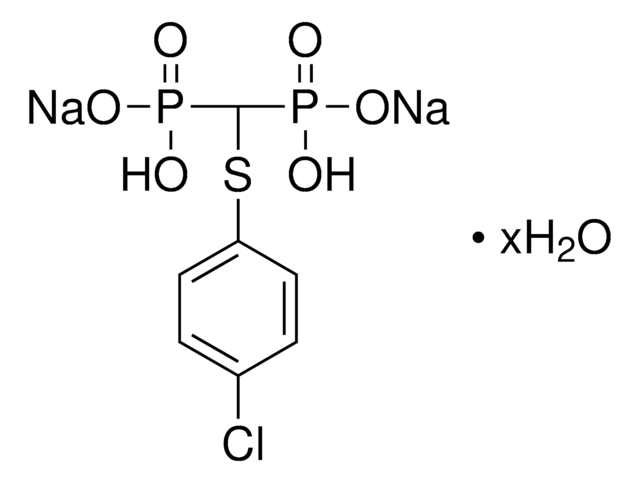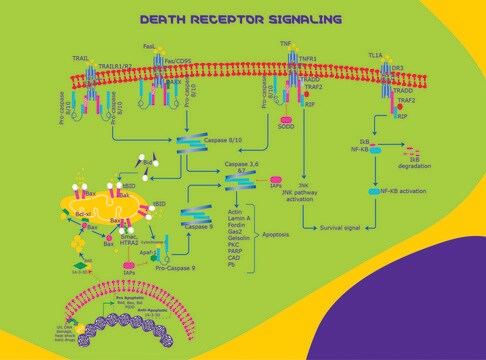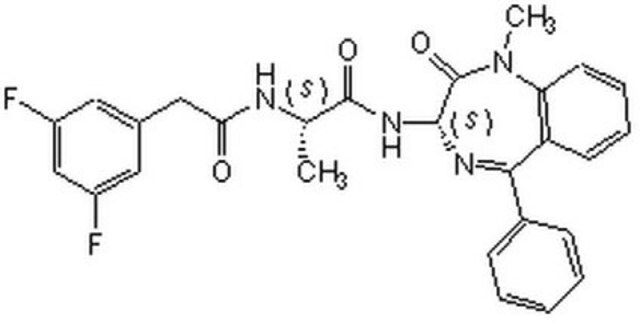T9701
TRAIL human
recombinant, expressed in E. coli, ≥98% (SDS-PAGE and HPLC), lyophilized powder
Sinonimo/i:
Apo2 Ligand, TL2
Autenticatiper visualizzare i prezzi riservati alla tua organizzazione & contrattuali
About This Item
Prodotti consigliati
Origine biologica
human
Livello qualitativo
Ricombinante
expressed in E. coli
Descrizione
extracellular domain
Saggio
≥98% (SDS-PAGE and HPLC)
Stato
lyophilized powder
PM
19.6 kDa
predicted mol wt ~21 kDa
tecniche
immunofluorescence: suitable
Impurezze
endotoxin, tested
N° accesso UniProt
Temperatura di conservazione
−20°C
Informazioni sul gene
human ... TNFSF10(8743)
Cerchi prodotti simili? Visita Guida al confronto tra prodotti
Applicazioni
Human TRAIL can be used as a selection agent for treating human cells for phenotypic enrichments. The product can also be used in chemical transfection for identifying Small RNA Modulators of TRAIL-Induced Apoptosis Pathway by utilizing libraries of synthetic small interfering RNA (siRNA) and microRNAs (miRNA).
TRAIL human has been used in immunofluorescence analyses, to study the delocalization of melanoma antigen-D2 in the nucleoplasm after a cellular stress.
Azioni biochim/fisiol
TNF-related apoptosis-inducing ligand (TRAIL) is a type II transmembrane protein that belongs to TNF family. The product present in both soluble as well as membrane-bound form, can induce rapid apoptosis of various transformed cell lines but not the normal cells. Additionally, the product can also induce apoptotic cell death in TRAIL-sensitive U343MG cells.
TRAIL is a cytokine with anti-inflammatory, and antitumor activity. It is expressed in various cells including immune cells, vascular cells and adipocytes. TRAIL is associated with vascular endothelial cell protection.
Type II transmembrane protein of the TNF superfamily. Ligand for apoptosis-inducing death receptors DR4 and DR5, decoy receptors DcR1 and DcR2, and osteoprotegerin. Approximately 28% amino acid sequence identity to FAS ligand. Human and mouse TRAIL share 65% sequence identity.
Stato fisico
Lyophilized from phosphate buffered saline
Risultati analitici
The biological activity is determined by its ability to induce apoptotic cell death in TRAIL-sensitive LN-18 cells.
Codice della classe di stoccaggio
11 - Combustible Solids
Classe di pericolosità dell'acqua (WGK)
WGK 3
Punto d’infiammabilità (°F)
Not applicable
Punto d’infiammabilità (°C)
Not applicable
Scegli una delle versioni più recenti:
Possiedi già questo prodotto?
I documenti relativi ai prodotti acquistati recentemente sono disponibili nell’Archivio dei documenti.
I clienti hanno visto anche
Lower maternal serum tumor necrosis factor-related apoptosis-inducing ligand (TRAIL) levels in early preeclampsia. A retrospective study
Morano D, et al.
Pregnancy hypertension, 12, 1-5 (2018)
Jan E Carette et al.
Nature biotechnology, 29(6), 542-546 (2011-05-31)
Insertional mutagenesis in a haploid background can disrupt gene function. We extend our earlier work by using a retroviral gene-trap vector to generate insertions in >98% of the genes expressed in a human cancer cell line that is haploid for
Melanoma antigen-D2: a nucleolar protein undergoing delocalization during cell cycle and after cellular stress
Pirlot C, et al.
Biochimica et Biophysica Acta - Molecular Cell Research, 1863(4), 581-595 (2016)
Synergistic effect of TRAIL and irradiation in elimination of glioblastoma stem-like cells
Liu J, et al.
Clinical and Experimental Medicine, 1-13 (2018)
Fatih Birtekocak et al.
Iranian journal of pharmaceutical research : IJPR, 20(2), 45-56 (2021-09-28)
Colon cancer is one of the most prominent causes of cancer-related morbidity and mortality and curable if detected in the early stages. TNF-related apoptosis-inducing ligand (TRAIL) is a therapeutic protein and has a potential anti-cancer activity that is widely used
Il team dei nostri ricercatori vanta grande esperienza in tutte le aree della ricerca quali Life Science, scienza dei materiali, sintesi chimica, cromatografia, discipline analitiche, ecc..
Contatta l'Assistenza Tecnica.








